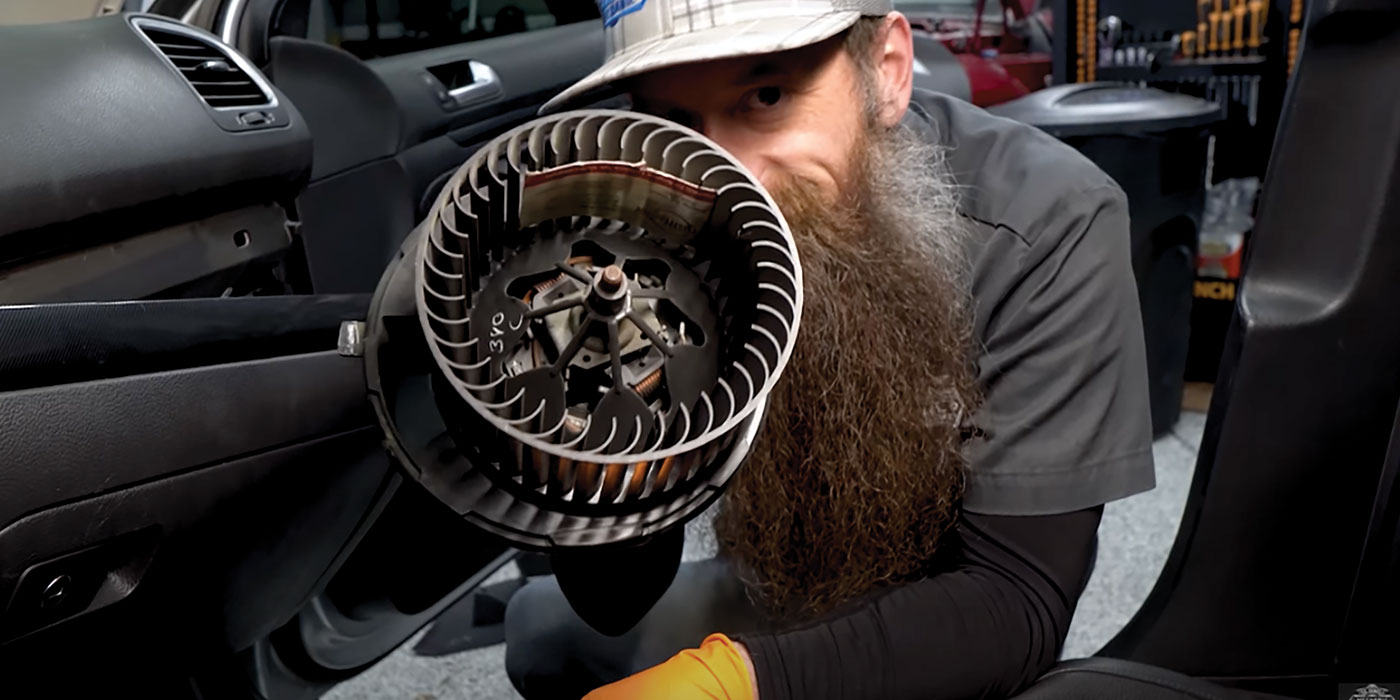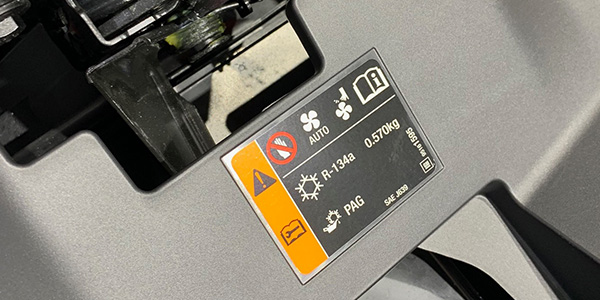I must have worked on Mercedes-Benz automobiles for 15 years before I ever replaced an evaporator. Through the 1970s, we pulled many an evaporator out of 107 and 116 chassis models to repair a poorly designed interior drainage system. The early models had little flappers on two interior tubes that carried the condensation to a lower tray that had the external drains. Originally, we were to open the case and snip the flapper from the end of the rubber tube.
Later, Mercedes-Benz came out with instructions and parts for the addition of two more external drains. The 114/115 chassis cars were equipped with heater motors that couldn’t be removed without the removal of the evaporator case. The need for a heater blower now “totals” those cars.
Metallurgical changes were made in the mid-’80s, probably to save weight. Copper/brass were replaced with aluminum. Now, nearly 20 years later, evaporators are probably the #2 refrigeration problem, behind compressors. Though #2 in occurrence, evaporators are becoming a big #1 in cost.
Timely Work
Many manufacturers made provisions for easy removal of their evaporators, foreseeing replacement during the car’s life. My experience with Mercedes-Benz says that they buried it because it would never need to be changed and then something went wrong. Two of its finest lines of the last 20 years, the 124 and 140 chassis, now come with footnotes about their cost of ownership due to air conditioning costs. It takes about 12 hours for the 124 model evaporator replacement, 22 hours for 140 chassis evaporator jobs.
There really isn’t any theory to be discussed about evaporators, and “R & R” instructions are contained in all the electronic data service and repair systems (ALLDATA, Mitchell 1, etc.) However, there are a few pointers worth noting. I found one from the iATN archives (www.iatn.net). According to one iATN poster, it is possible to crack the windshield if the car is lifted with the dash brace removed.
And, I can tell from experience both how easy and expensive it is to chip the center console wood on a 140 chassis model. I have also noticed that the $1,140 dash of the early models has been replaced by a $3,820 version on ’95 and up models. Be careful and remember the risk factor when estimating.
When doing the evaporator on 124 models, we always include all the vacuum mode actuators. They have a 10-15 year life and some are almost as hard to replace as the evaporator. The part numbers are: 124 800 00 75, 124 800 02 75, 124 800 03 75, 124 800 04 75 and 124 800 11 75. When replacing the unit on the early 140 models, there is an additional spacer/baffle, P/N 140 831 08 36, that must be added as the later-model evaporator has been reduced in size.
All of these are good examples of why a full function test should be performed by operating all of the normal functions of the pushbutton, including auto, manual and REST. Activating the pushbutton diagnostic mode and checking actual values, codes and activation of flaps will also save time and embarrassing moments if an evaporator replacement is justified. Oftentimes, a technician will not perform these checks only to replace the evaporator. And when the task is completed, he finds a leaking flap, or a defective sensor or pushbutton assembly. Now, he must approach the customer for additional repairs that could have been avoided if the above simple tests had been performed. Most technicians are paid 1.5 hours for these tests that can accurately be performed in 30 to 45 minutes.
M-B A/C Diagnostics
Since we are inside the car, I would like to address the great diagnostic capabilities available with the modern pushbutton controller. Three different forms of diagnostic information can be gathered here. I find the “actual value” function most helpful. Diagnostic trouble codes are also available, along with the ability to activate the individual door positions (individual flap tests) within the dash. All of these functions, actual values, fault codes and mode activation, can be done from the various buttons on the pushbutton assembly.
Actual Value
I really like the actual values, as one can drive the car and watch the activity of important functions that include evaporator temperature, engine temperature, blower control voltage, etc. See Chart 1 for the list of actual values for the 210 chassis E320. Other chassis are similar, but this chart is given as an example.
The procedures for reading Actual Values go like this: Turn on the ignition, press the “AUTO” button, set the temperature on each side to 72° F (this can be done quickly by pressing both the red and blue arrows at the same time), then press the “REST” button for five seconds or until the left-side display says “1.”
The right-side display will then display the in-car temperature. Pressing the “AUTO” on one side makes the positions change up or down (for example, 1, 2, 3, etc). Pressing the opposite “AUTO” button runs the functions in the other direction (for example, 3, 2, 1). The test can be ended at any time by tapping the “REST” button.
 Photo 1 shows the Actual Value screen. It is value #5, which is evaporator temperature. The right-side value of 06 is the temperature in Celsius.
Photo 1 shows the Actual Value screen. It is value #5, which is evaporator temperature. The right-side value of 06 is the temperature in Celsius.
I first ran across these tests while trying to solve a C230 problem whereby its compressor would shut off within one minute of starting. There were some fault codes involved with communication between the fan control module and the pushbutton module. I came across the actual value test while trying to make some sense of the code. I tried the actual values without the engine running. The evaporator temperature showed 155°. When I discovered that the dealer had two of the sensors in stock, I had a good idea that the problem had been found. The new sensor gave me realistic values and the problem was fixed. That model has a variable displacement compressor and it was interesting to watch the evaporator temperature while on a road test. It dropped rapidly, then slowed and finally just stopped at 42°. (It was probably 95° outside at the time). This feature has many values, as the list of data is comprehensive — engine temperature, engine speed, vehicle speed, battery voltage — to name a few.
Pulling Fault Codes
The procedures for pulling Fault Codes go like this (see Chart 3): Turn on the ignition, and set the left temperature to “HI” and the right temperature to “LO.” Then, simultaneously press buttons “Rest” and “EC” for five or more seconds. All of this must be done within 20 seconds. The “Recirculate” button will flash its LED. The screen will then go blank, and the first code can be brought up by pressing the right “AUTO” button.
 Subsequent codes are retrieved by additional application of the right “AUTO” button. Photo 2 shows code B1234. Note that the code starts with “E” for error. Also note that the B1234 code appears as Eb1 234 on the screen.
Subsequent codes are retrieved by additional application of the right “AUTO” button. Photo 2 shows code B1234. Note that the code starts with “E” for error. Also note that the B1234 code appears as Eb1 234 on the screen.
Flap Test
The Individual Flap Tests are run by idling the engine, pressing the left and right “AUTO” buttons, setting temperatures to 72°, manually opening the fascia vents, and simultaneously pressing the “Rest” and “Recirculate” buttons for more than five seconds. The first step: Left display “0” and right display “LO” should appear. Pressing the left “AUTO” button changes the steps. Pressing the right “AUTO” button varies the two modes “HI” and “LO” for each step.  The functions that are checked are described in Chart 2 and can be verified by the actual air flow changes enacted. Photo 3 shows the third step (DTC) with “2” indicated on the left side and the “HI” mode indicated on the right.
The functions that are checked are described in Chart 2 and can be verified by the actual air flow changes enacted. Photo 3 shows the third step (DTC) with “2” indicated on the left side and the “HI” mode indicated on the right.
Note: All of these tests are so easy to run that they should be done frequently to gain familiarity with them. And, they definitely should be run before and after major dash surgery!
For more A/C-related tips and service information for addressing Mercedes-Benz vehicles, visit the Luxury Motor Vehicle Information System website at www.lmvind.com, or STAR TekInfo, the official Mercedes-Benz USA site for hosting service and repair technical documentation at www.startekinfo.com.
|
New Aftermarket Replacement Parts for GM’s Electronic Viscous Cooling Fan System
Four Seasons recently began offering to warehouse distributors, jobbers and national program distribution groups the industry’s first replacement parts for the General Motors Electronic Viscous (EV) Cooling Fan System. The GM EV Fan Clutch has a unique system design and uses the electronic engine performancer data stream and a mechanical thermo-coupler to determine the necessary fan engagement time, providing a pulse width signal that keeps the vehicle running at optimum fuel efficiency and prevents overheating. The PCM utilizes sensor inputs from the coolant sensor, intake air temperature sensor, transmission oil temperature, speed sensor, A/C system pressure sensors and an internal thermocoupler. This data is converted into a 12-volt pulse width modulated signal (PWM), which is then sent to the relay to regulate and control fan “on” time. The relay sends the power to the fan clutch solenoid, which, when energized, allows fluid to pass the spring-loaded valves and to lock up the clutch. This pulsing on and off of the solenoid regulates the fan speed. The longer the relay time, the faster the fan speed, which produces a better cooling system – which, in turn, increases fuel economy. The PCM then monitors the fan speed using a three-wire Hall effect sensor on the clutch, which sends a voltage back on the signal line. Several inputs can cause the PCM to keep the cooling fan operating full-time: when the engine coolant temperature exceeds 264° F; the transmission oil temperature exceeds 304° F; the air conditioning refrigerant high-side pressure exceeds 240 psi; or there are individual or multiple DTCs being set. For more information on this and other A/C products for passenger cars, SUVs, trucks and fleets, visit the Four Seasons website at www.4seasonsinc.com. |
|
Double-Pipe Internal Heat Exchanger Developed for Front Car A/C
Tokyo — DENSO Corp. has developed a unique double-pipe internal heat exchanger for a car air conditioning system, increasing cooling performance by up to 12%. DENSO is the first to develop the double-pipe internal heat exchanger for a front A/C system that needs to be installed in a limited space. The A/C system was introduced this year at car shows in the Middle and Near East on the Toyota Prado and in North America on the Lexus GX470. The double-pipe internal heat exchanger integrates two pipes, which are separated in a conventional refrigeration cycle, into one pipe with inner and outer tubes. In the refrigeration cycle, the low-temperature gaseous refrigerant flows in the inner tube and exchanges heat with the high-temperature liquid refrigerant flowing in the gap between the inner and outer tubes. In DENSO’s double-pipe internal heat exchanger, the inner tube wall has spiral grooves that face the outer tube, enhancing heat exchange. This allows the internal heat exchanger to achieve a higher cooling performance within a shorter pipe length. With this unique structure, DENSO’s double-pipe internal heat exchanger can increase cooling performance by 5% to 12% at the same power level, with a length of only 40 centimeters (approximately 16”). When the A/C system is installed in the engine compartment, pipes need to be flexible so they can be bent to fit with the other systems and components. However, in the double-pipe internal heat exchanger, the gap between the inner and outer tubes is likely to be crushed during the bending process, making it unable to function as a refrigerant path. DENSO solved this problem by creating the spiral grooves on the inner tube wall. As a result, the tubes are not crushed when bent, and A/C systems using DENSO’s double-pipe internal heat exchanger can be installed in the same space as a conventional front A/C system. For more information, visit www.globaldenso.com. |
|
Developmental Refrigerant Meets Global Warming Regulation
Morristown, NJ — Honeywell announced in mid-February that it has patented developmental refrigerant for automotive air conditioning applications that will meet 2011 European Union environmental standards for reducing use of global warming potential (GWP) substances. This latest technology is part of Honeywell’s continued long-term initiative to address current and potential regulatory requirements and to meet the changing needs of its customers. In the 1990s, Honeywell helped manufacturers replace ozone-depleting refrigerants and improve the energy efficiency of stationary A/C systems. Honeywell’s new, low-GWP refrigerant was announced as auto manufacturers and their suppliers gathered in Saalfelden, Austria, in February for the Mobile Air Conditioning (MAC) Summit. The event was hosted by the European Commission. At the MAC Summit, the European Commission addressed its Mobile Air-Conditioning Directive, which mandates the phaseout of hydrofluorocarbon (HFC) R-134a beginning in 2011 for all new auto platforms. The EU-required phaseout was based on predictions that long-term use of existing refrigerants could contribute to global warming. Honeywell’s new technology is a substitute for HFC-134a. The company said testing showed that its new technology can be used as a direct replacement for HFC-134a with minimal reengineering of automotive systems, and that its engineers contend that it is a more practical and cost-effective solution than CO2. Honeywell said it would provide additional details on its new technology in March at the Society of Automotive Engineers of Japan (JSAE) Automotive Air-Conditioning Conference in Tokyo. Underhood Service will provide more details as they become available. |







